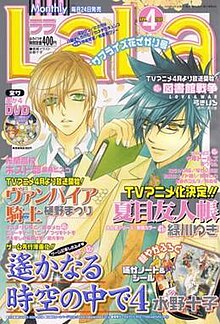LaLa
 | |
 Cover of April 2008 issue featuring Harukanaru Toki no Naka de by Tōko Mizuno | |
| Editor-in-chief | Ikushū Ichikawa |
|---|---|
| Categories | Shōjo manga[1] |
| Frequency | Monthly |
| Circulation |
|
| First issue | July 1976 |
| Company | Hakusensha |
| Country | Japan |
| Based in | Chiyoda-ku, Tokyo |
| Language | Japanese |
| Website | lala |
LaLa is a monthly Japanese shōjo manga magazine published by Hakusensha on the 24th of each month. The magazine's bonus contents are usually calendars for New Year issues, drama CDs, and so on. In a 2006 survey conducted by Oricon, Japanese girls selected LaLa as their fifth favorite manga anthology, along with Shogakukan's Shōjo Comic and Kodansha's Weekly Shōnen Magazine.[2][3]
About[edit]
LaLa is the second shōjo manga magazine Hakusensha published. Manga serialized in LaLa are collected into tankōbon under the label "Hana to Yume Comics" (花とゆめコミックス), along with manga serialized in Hana to Yume. Fanbooks and illustration books for its series are published under the label "Hana to Yume Comics Special" (花とゆめコミックススペシャル).
Readers of the magazine are 97% female, while the other 3% are male readers. Its age demographic consists of 4% percent for under-13 readers, 23.4% for readers aged 13–17, 20% for readers aged 18–20, 13% for readers aged 21–23, while the remaining 29.7% of the readers are aged 24 years old and up.[4] Readers aged 24 and up are the demographic of the highest percentage.[4]
History[edit]
LaLa began its publication in July 1976 as a sister magazine to Hana to Yume. It was originally titled Hana to Yume LaLa (花とゆめ LaLa) and published bi-monthly. The magazine's first issue featured Ryoko Yamagishi's Hana no Seitachi (花の精たち) and was priced at 290 yen. The magazine's first editor-in-chief was Nobumasa Konagai. The current[timeframe?] editor-in-chief is Ikushū Ichikawa.[5]
In September 1977, the magazine changed its frequency and became a monthly magazine. It then became its own independent magazine.
In 1985, Hakusensha started irregularly publishing special publications of LaLa under different titles. It started with LaLa Deluxe, published seasonally. LaLa Deluxe later became the magazine's sister magazine LaLa DX.
Since the publication of LaLa Deluxe, various special or supplement issues have been published. Bessatsu LaLa: Bessatsu RaRa (別冊LaLa : 別冊ララ) was the first supplemental issue for LaLa. It was first published in Summer 1982 and ended in Spring 1984.[6] Bessatsu LaLa (別冊Lala) succeeded Bessatsu LaLa: Bessatsu RaRa and was published bi-monthly from 1984 to 1985.[7]
My LaLa, a special edited compilation of the magazine, was published from Autumn 1984 to Spring 1985.[8] LaLa Special Wendy (LaLaスペシャルWendy) was published from Summer 1985 to June 1986, for a total of five issues.[9]
LaLa Special Cindy (LaLaスペシャルCindy) then replaced LaLa Special Wendy. The first issue of LaLa Special Cindy was published from Summer 1986 to Autumn 1986. It was later revived for two issues, which were published from the Autumn to the Winter 1987 issues.[10]
Since 2004, special or supplemental issues of LaLa have been published as LaLa Special, which serializes LaLa's side stories of the related series, as well as featuring various manga artists' one-shots.
Television commercials[edit]
The magazine had a series of commercials directed by Shō Yanagisawa called LaLa Kara no Oshirase (LaLaからのお知らせ, "Information from LaLa").[11] This series of commercials won the Grand Prix award in the film category for "Best of Communication Media and Publication" in Ad Fest 2009.[12] LaLa Kara no Oshirase Sui'ei Hen (LaLaからのお知らせ 水泳 篇) and LaLa Kara no Oshirase Chikyū Ondanka Hen (LaLaからのお知らせ 地球温暖化篇) also won two silver medals in the same event.[12] The series was also named as one of the "Gold Stars" in the 2nd Ad Stars 2009 Busan International Advertising Festival.[13]
Serializations[edit]
Current[edit]
- Natsume's Book of Friends (2005–present)
- School Babysitters (2009–present)
- Snow White with the Red Hair (2011–present)
- Tales of the Tendo Family (2017–present)
- The Dark History of the Reincarnated Villainess (2018–present)
- Shunka Shūtō Daikōsha Haru no Mai (2022–present)
Past[edit]
References[edit]
- ^ a b "Girl's Manga" (in Japanese). Japanese Magazine Publishers Association. September 2016. Retrieved November 6, 2016.
- ^ 意外!?女のコが一番好きなコミック誌は「週刊少年ジャンプ」! (in Japanese). Oricon. Archived from the original on April 10, 2006. Retrieved October 17, 2009.
- ^ "Weekly Shōnen Jump Top Anthology with Girls". Anime News Network. Retrieved October 17, 2009.
- ^ a b "JMPA読者構成データ - LaLa" (PDF). Japanese Magazine Publishers' Association (in Japanese). Retrieved August 14, 2009.
- ^ "テレビアニメ『夏目友人帳』の製作発表会リポート【PV場面カットも公開】 - ファミ通.com". Famitsu (in Japanese). Retrieved February 2, 2010.
- ^ "国立国会図書館 NDL-OPAC(書誌 詳細表示 ) - 別冊LaLa : 別冊ララ" (in Japanese). National Diet Library. Retrieved January 29, 2010.
- ^ "国立国会図書館 NDL-OPAC(書誌 詳細表示 ) - 別冊LaLa" (in Japanese). National Diet Library. Retrieved January 29, 2010.
- ^ "国立国会図書館 NDL-OPAC(書誌 詳細表示 ) - My LaLa" (in Japanese). National Diet Library. Retrieved January 29, 2010.
- ^ "国立国会図書館 NDL-OPAC(書誌 詳細表示 ) - Wendy : Lalaスペシャル" (in Japanese). National Diet Library. Retrieved January 29, 2010.
- ^ "国立国会図書館 NDL-OPAC(書誌 詳細表示 ) - Cindy : Lalaスペシャル" (in Japanese). National Diet Library. Retrieved January 29, 2010.
- ^ イー・スピリット キャスティング受賞作品集 キャスティング・広告制作・ホームページ制作・キャンペーン (in Japanese). E-Spirit. Archived from the original on April 19, 2010. Retrieved January 28, 2010.
- ^ a b アサツー ディ・ケイ、第12回「アジア太平洋広告祭(アド・フェスト2009)」でフィルム部門グランプリを受賞 (in Japanese). Asatsu-DK Inc. Retrieved April 22, 2015.
- ^ "Busan Ad Stars, On Track to International Renown". Adobo/Sanserif, Inc. Archived from the original on October 4, 2009. Retrieved January 28, 2010.
- ^ "祝・「夏目友人帳」第100話!LaLa全作品にニャンコ先生がかくれんぼ" [Celebrating the 100th episode of Natsume's Book of Friends! Nyankosensei plays hide-and-seek throughout LaLa]. Natalie (in Japanese). Natasha, Inc. 2019-05-24. Archived from the original on 2021-11-04. Retrieved 2021-11-05.
- ^ "「天堂家物語」ボイスドラマがLaLaに!石川界人、高橋李依、三木眞一郎が出演" [Tendou-ke Monogatari voice drama coming to LaLa! Featuring Kaito Ishikawa, Rie Takahashi, and Shin-ichiro Miki]. Natalie (in Japanese). Natasha, Inc. Archived from the original on 2021-10-14. Retrieved 2021-11-05.
External links[edit]
- Official website (in Japanese)
- A history of the magazine at Comic Natalie (in Japanese)
- LaLa at Anime News Network's encyclopedia
